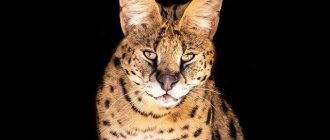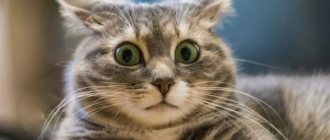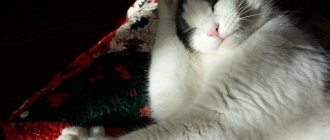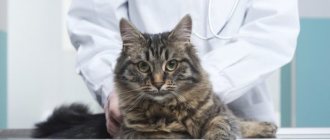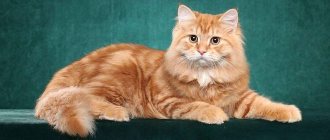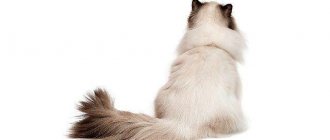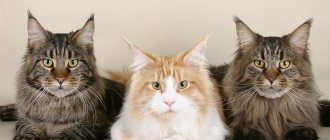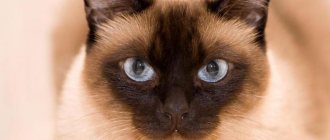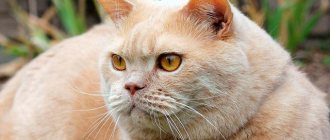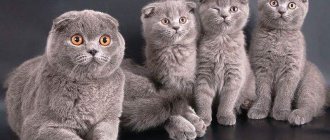Author: Eva Tushenkina
21 June 2022 14:08
Community: Life is not the same without a cat
Tags: Unusual cat animals cat kitten Narnia unusual color unique
22180
13
This beautiful blue-eyed cat named Narnia captivated everyone back in 2022, when he was a tiny fluffy ball with a muzzle clearly divided into black and gray halves. And now he is no longer a baby, but an adult respectable cat, the father of children and a real heartthrob!
1
See all photos in the gallery
Wild colors of cats: a little history
Once upon a time, wild cats lived in Europe and Africa, which did not differ in a wide variety of colors. For example, European forest cats had mostly grayish coats with the addition of ocher. The steppe cat had stripes “painted” on its fur of a sandy or grayish tint. Sometimes stripes replaced spots. That's probably all the diversity. So where did modern colors come from?
About five thousand years ago, the cat was domesticated by humans. Animals traveled around the world on ships, settled in different places, and experienced many mutations, as a result of which their color changed. Selection was of great importance. Some breeders are still working on unusual colors for pets. For example, for lovers of wild animals, cats similar to a panther or jaguar were bred. However, they have a docile nature as pets.
Is it worth keeping the stray stuff for yourself?
If you drive an animal away using brute physical force, the cat may become offended. Then the troubles from which the furry beauty tried to protect the house will hit the household with greater force.
She should be sheltered, warmed and fed with treats. If the animal remains in the house, you should find good owners for it. In this case, trouble will bypass your home.
https://youtube.com/watch?v=vI_pKHVMJsg
Cats have a wayward character, but at the same time they are playful and affectionate. It is believed that they travel between worlds, see the aura and inner world of a person, his thoughts and desires, and also bring prosperity and good luck to household members. Fluffies live in large families, and are also excellent friends for elderly lonely people; they keenly sense the mood of their owners and determine the general atmosphere in the house. Therefore, regardless of a person’s personal attitude towards cats, they should not be offended.
Genes and color
The color of a pet's fur depends on the genes that are responsible for it. And, by the way, there are not so many of them. But if there are different forms of the same gene, the color can change, have different shades and patterns. Sometimes the fur coat is so unusual and painted in such colors that it makes professional breeders and ordinary cat lovers admire.
The basic colors of pets are the basis for the rest. These include only two colors: red (red) and black. Black color appears in the presence of a special pigment called eumelanin, and red color appears in the presence of pheomelanin. The intensity of the color depends on how much melanin is contained in the hair.
Gene brighteners produce completely different colors. The brightener for black is gray (blue), for red – cream.
Cats have genes that produce white coloring with different interpretations, as well as genes responsible for patterns on the fur coat. Therefore, a bizarre pattern sometimes appears on it, ranging from ordinary stripes to mysterious curls, which are also called marble color.
A cat's coat color can be red, black, or a lightened variety of these colors, as they have an XY chromosome set. Females have a set of XX chromosomes, therefore, their color combines a greater number of shades. Therefore, the hair colors of females are more varied and bizarre. A tricolor cat is not uncommon, but it is almost impossible to find a cat of this color.
See also: The smallest cat: which breed to prefer
There are also cats that have a black and red base color at the same time. But these are gene mutations. The set of chromosomes in such animals is XXY.
Now let's talk in more detail about the main colors.
What color Maine Coon is better to choose?
Many breeders tend to prefer wild-colored Maine Coons. They are usually called black tabby. The basis is the belief that this is the color of the coat that the first forest cats, from which the breed originated, had.
Very often, buyers choose blue cats. They are really beautiful. It’s not for nothing that Maine Coons of this color can be seen in popular advertising. But thanks to her, the price has increased.
People prone to mysticism love cats with black fur, are willing to pay huge sums for them and call them by the most unusual nicknames.
Cats with silver fur are attractive. There is something mysterious and attractive about this color.
But they are careful not to buy white Maine Coons, knowing their tendency to deafness.
Whatever color Maine Coon you buy, proper feeding and care of the animal is of great importance. A healthy animal is full of strength, its coat is shiny. A playful man-kun will always please his owner.
Ginger cat
Everyone loves cute saffron milk caps. No wonder they are believed to bring happiness to the house. The mere presence of a sunny cat can improve your mood. The red color is called pheomelanistic. The genes responsible for the appearance of red cats are dominant O and recessive O. In the chromosome they are combined into pairs of alleles (OO), (oo).
There are also genes on which the color intensity depends, the dominant gene (D) and the recessive gene (d). Combining with intensity genes in pairs, the genes form a bright red sunny color (ОD), or cream color (Od).
The colors of females are more varied than the colors of males, but mostly cats are red. The fact is that cats only have a set of XY chromosomes, and the color directly depends on the presence of the X chromosome. A cat becomes red only if it has two X chromosomes, each of which has a gene for red color.
How to choose a kitten
In Europe, especially in the USA, as well as in Russia in recent years, the Maine Coon breed of unique raccoon cats, despite its relatively high price, is very popular. These giants, calm and docile by nature, take root well in the house, love their owner and are friendly towards small children. They are fun to play with, Maines are active and mobile and respond well to training. Often unscrupulous breeders do not sell purebred coons.
The task of choosing a Maine Coon kitten is not easy and requires following simple but important tips:
Firstly, learn more from books and the Internet about the distinctive, standard characteristics of coons. They visit exhibitions, study what the Maine cat breed and small kittens look like. Secondly, they look for a nursery with a good reputation and communicate with the owners and their pets. An honest breeder will tell you everything about the babies and help you choose. It will guarantee that the kittens are purebred Maine Coons and not mestizos. Then they take a closer look at all the specimens from the lambing. Even at a young age, coon kittens differ from each other and have an individual character. One is restless, constantly spinning, and the other, on the contrary, is balanced. The third eats greedily and with pleasure
Intuition, as a rule, will tell you which one is more suitable and will become a favorite in the house. Choosing gender, boy or girl, is not so important. The indigenous Maine Coon breed, according to the rules of felinological standards, is crossed only within the species, therefore kittens of the “pet” class are neutered before sale. The buyer independently, visually, examines the future pet for signs of disease, looks through and feels the fur, which is fluffy and silky without bald spots, insects and dandruff. Checks how clean the eyes and ears are and whether there is any purulent discharge anywhere, especially from the genitals. At the time of sale, the kitten must be more than 3 months old
At 2 months he should receive the first set of vaccinations in the nursery. It is good if he is weaned from breastfeeding and transferred to independent feeding. Learn about the diet in detail.
What to pay attention to
What coat color the Maine has is important, but not essential. All the coons are big handsome men and look great, to the envy of others
External purebred characteristics of the breed are studied more closely
Pay attention to:
- massive, rectangular body with a wide chest and a square head;
- on a slightly elongated muzzle, large pointed ears with funny tassels, a distinctive feature of Maines;
- the eyes have a slightly slanted appearance, which gives them a predatory look, making them look like a lynx;
- the tail, the pride of the Mui people, is long and fluffy, covering the entire body.
How to distinguish the breed
It is difficult to distinguish a purebred, real Maine in infancy from a mestizo, a simple cat. A specialist in standard breed characteristics can help you distinguish. The main feature is that coons at 3 months of age are always much larger than their outbred counterparts and on average the weight of girls reaches 2 kg, and for boys 2.5 kg, and for ordinary cats up to 1.5 kg. The maine's body is well formed, large, covered with thick, silky hair with a massive head, with a fluffy long, thick tail. The paws are of medium length, look powerful, polydactic, with tufts of hair visible between the six toes. The Maine Coon's passport contains a pedigree note with data on at least 4 generations of ancestors.
Black cat
People treat black cats differently, although color does not in any way affect the character and behavior of the animals. Eumelanistic or black colors come in three types: black (B-black), brown (b-brown), light brown (bl-brown light). The strongest gene is B, and the weakest is bl. In any pair, the dominant gene predominates: Bb - the cat will be black, Bbl - also black, bbl - chocolate.
Colors also depend on the presence of intensity genes: BBDD – rich black (solid), BBDd black, BBdd blue (gray).
Gene O is stronger than gene B. So a black cat and a red cat will have red kittens.
Folk superstitions
Our ancestors looked for answers in the behavior of cats to what awaited them in the near future:
The cat joined the house - expect an imminent wedding. Long and diligent licking of fur is good for guests. The pet reaches out to its owner to expect new clothes. But this sign also has another interpretation - someone from one’s close circle will use the person for selfish reasons. To offend a cat means disaster. The animal will definitely do something unpleasant in response, and this will be the best outcome. Cats are associated with the other world, so revenge for an offense caused can be serious. A person who offends a cat may soon fall ill, and only misfortunes and troubles await him.
You can't look a cat in the eye for too long. This can lead to trouble. The pet views a close, prolonged gaze as a threat and may behave aggressively. Cats see brownies and communicate with them. Pets often wake up their owners with noisy, active games at night. But you can’t be angry with a cat and punish it. Together with her, the brownie will also be offended, for which he will definitely take revenge on the household. Cats protect against evil spirits. If an animal suddenly huddles in a corner and becomes wary, at that moment it sees the source of evil spirits. The pet needs help to drive away the evil spirit. To do this, you need to take a broom and use it to drive the evil spirits out of the house, saying protective prayers. A cat protects against the evil eye and damage. If you have had contact with a person who has bad intentions, you should use the strong cat energy. The pet must be picked up and stroked, but only with the left hand
It is important to stroke the cat exactly on the scruff of the neck. If a cat was calmly walking down the street, but, seeing a stranger walking ahead, suddenly changed its route, the person following the animal should take a few steps to the side (it doesn’t matter which way) and then continue on its way. This will protect you from trouble. You cannot kiss an animal on the nose - when a person touches a cat’s nose, it opens an energy channel through which not only his life energy, but also particles of his soul can escape. The cat sneezed
If this happened at a wedding, and the animal was next to the bride at the time of sneezing, this is a good sign indicating that the life of the young couple will be happy. If a pet sneezes 3 times in a row, it will rain or the owner will get sick. The cat sneezes - the owner will have a toothache. To prevent this from happening, after your pet sneezes, you need to say: “Hello!”
Cats heal. And these are not only those situations when an animal lies on a sore spot on the human body. There is a belief that the water in which the cat was bought helps cure serious illnesses. After bathing a pet, the water from the bath should not be poured out; the sick person should bathe in it. Then the water needs to be poured as far as possible from the house so that the disease goes away and does not return.
It is believed that the cat not only sees the brownie, but is also at his disposal.
White cat
Absolutely white albino cats are extremely rare. In fact, white color has nothing to do with albinism. These are completely different things. Albinism is recessive and is designated by the “c” gene, and there are two types of albinos: those with blue eyes and those whose eyes appear red.
Now about the genes that give white color. It depends on two genes, dominant - W and recessive - w. Moreover, the gene itself does not give any color, it simply suppresses other genes, which is why the cat remains white.
When crossing two cats with WW, the offspring will have a white coat, and cats with Ww will produce offspring with pigment. Such cats are more common.
White cats are often deaf due to the fact that the deafness gene is often “stuck” to the W gene or the S gene, which is responsible for the presence of white spots. Moreover, almost half of white animals are born deaf.
Rules for choosing a nickname
Whatever name the owners want to name the gray kitten, you must always adhere to certain rules. The name should not be too long and complex; the baby simply will not be able to remember it. The nickname should be sonorous and easy to pronounce. Then, hearing his name every time, the gray bundle of happiness will joyfully run towards his household.
Animal psychologists recommend choosing a cat name that has hissing sounds. It is the hissing and rustling that caresses the animal’s ears. This is explained by the fact that such sounds influence the centers of the feline’s subconscious, which are responsible for the basic instincts - hunting, obtaining food. With a hissing and rustling nickname, the cat will feel like a little lion, the ruler of this world.
When choosing a name “for fun,” as some people do, it’s worth thinking about such a nuance as the constant feeling of awkwardness when you have to call your pet every time in front of strangers.
Tortoiseshell or calico cats
Cats that have spots of two colors all over their coats can surprise anyone with their “outfit.” After all, not all females have red genes on their two X chromosomes. Often, genes for black color are present on the second chromosome, resulting in the birth of such a spotted animal. The main tortoiseshell color is black and red, but there are other colors: blue and cream, chocolate and cinnamon.
See also: The most expensive cats in the world in 2022
Mostly females have a tortoiseshell color. In cats, this color occurs only with a set of XXY chromosomes (as a rule, such cats are sterile).
Are there differences in character and behavior?
Blue cats are aristocrats not only in appearance, but also in behavior. They are characterized by the habits of a high-born animal, supposedly having not only a blue fur coat, but also blood of the same color.
They have an independent, proud character. From a young age they try on the role of master in the house; they simply do not accept any other status. At the same time, gray kittens develop such qualities as calmness and nobility even in childhood.
Growing up, they do not change for the worse; they are completely devoid of anger. They often have a playful disposition, but it happens that a cat grows up quite withdrawn and keeps its distance from others.
Did you know? The first cat astronaut was the French cat Felicette, which means Astrocat. This significant event took place in 1963.
Solid blue cats are intelligent and curious. Extremely loyal to the owner. Don't let this surprise you, but it happens. They love to sleep in the arms or chest of their owner, or simply spend an afternoon siesta there.
Loneliness does not frighten them. They will always find something to do to their liking when the owner is not at home. Moreover, their regal manners do not go away, and most often, cats of this color do not allow themselves to stoop to the pranks inherent in carriers of other colors. So feel free to leave your pet alone without fear of returning home to complete chaos.
Colors of ticked cats
The so-called ticked colors are very diverse. Each fur of these animals is divided into several shades: darker turns into light, then again into dark. Ticking is the result of the action of a dominant A gene called agouti. It acts in such a way that in the first stages of wool growth the pigment is released very strongly, then decreases. Alternation occurs several times, and sections of the hair are painted in different shades. When the animal moves, its fur seems to shimmer.
Breeders are very keen on breeding cats of these colors, as they believe that this is not an easy, but very interesting task.
Tabby colors
Tabbies are colors with a specific pattern: circles, stripes, spots on a ticked coat. For this purpose, the T gene is required. Due to the fact that some areas of the fur coat are painted, while others are not, a pattern appears.
For example, the T gene is responsible for the brindle color. For the Abyssinian color, when there are stripes only on the face, and ticked hairs are located throughout the fur coat - Ta.
Cats' fur coats can be not only brindle, but have the most bizarre patterns.
Piebald cats
If a cat has white spots, then its color is piebald, regardless of what color the white is adjacent to. Piebaldness is evidence that the S gene is present, which is also responsible for deafness. The piebald colors themselves are very diverse. The main ones are: van, harlequin bicolor, tricolor, tuxedo.
The van (Sw gene) is considered dominant; the harlequin is recessive to it, but is dominant to the bicolor, which itself is recessive (Ss).
Van cats have a colored cap on their head and a dark tail, and the rest of their fur is white, or rather it is believed that it has such a large white spot.
Van color cat
Pets whose body is covered with colored spots on no more than a third have a color called harlequin.
Harlequin
In animals that are half colored, the color is called bicolor .
Bicolor
The piebald breed also includes the snowshoe breed, which only cats of this breed have, with white shoes and a white shirtfront.
Snow-shoe
There are animals that have very little whiteness, a small speck in the form of a medallion or button. But sometimes the spots on the fur coat are located very close and are almost invisible, so that the cat seems like just a snow queen.
Cat with a medallion spot
Red Maine Coon kitten
Having decided to purchase a red and mischievous Maine Coon kitten, you need to choose the right nursery or breeder. To do this, just study useful information on the Internet, read previous customer reviews, and compare prices.
What is the price?
It is quite difficult to say definitely how much it will cost to buy a red Maine Coon kitten. In professional nurseries, their cost in Russia varies from 20 to 80 thousand rubles.
How to care in the first weeks after purchase?
When you purchase a Maine Coon kitten, you need to provide it with proper care in the first two weeks.
Once you purchase a kitten, he will definitely need to allocate his own corner in the house, where he will have a litter box, a bowl of water and food. It is also recommended to purchase special ladders, beds, houses, and toys for them. This breed is very active and playful and needs something to do all the time.
Maine Coon kittens quickly get used to their new home and owners. But do not forget that each cat is individual and has its own character. Your kitten may need a little more time to get used to the new environment. Maine Coon kittens are very curious, so as soon as he settles into his new home, he will begin to explore and study the space.
Best German Shepherd
What nicknames are suitable for boys and girls?
With the appearance of a kitten in the house, many people begin to wonder what to name the new tenant. Quite often, people find it difficult to choose a name, and choose it only after they have studied the habits and temperament of the kitten. According to statistics, red Maine Coon kittens are most often called by the following nicknames:
- girls: Orange, Ognetta, Mandarin, Fanta, Caramel, Spark;
- boys: Garfield, Luchik, Fox, Gold, Cupcake, Raisin, Fire.
Of course, choosing a name for a cat is a personal decision of their new owners. In addition, in professional nurseries quite often the names are already indicated in the animal’s passport.
To summarize, it is worth noting that the acquisition of a red Maine Coon is a whole event in the life of its new owners. This pet will give you a lot of positive emotions, joy and love.
Cats of gold and amber colors
Cats with golden coats are considered beauties, because their fur, with several tones, always seems unusual. It combines basal yellow color and ticking. The golden tones are produced by the wb or agouti genes.
Colors vary depending on the area of dyed hairs.
See also: Cat collar: varieties and areas of use
If painted:
- 1/2 hair or more, the cat has a smoky-golden coat;
- 1/3 of a hair, the animal has a golden-shaded color;
- 1/8 hair, coat almost yellow, color name chinchilla golden.
In addition, there is a golden tabby, with pronounced stripes of light brown color against the ticking background.
Amber tabby
And the last very interesting color, called amber (amber). Cats of this color have modified genes. Their color is based on a modified eumelanin pigment.
Amber color
Cats with silver color
Animals with silver-colored fur are the most mysterious, if only because scientists have not yet come to an exact conclusion about the formation of silver colors. But it is known for certain that the inhibitor l gene is responsible for them.
Silver color is obtained when part of the hair is highlighted using yellow (silver) or cream (cameo) colors.
The colors are divided as follows: golden: smoky, shaded, chinchilla, tabby.
- Smoky colors are obtained when the root of the hair is white, and the hair itself is lilac, chocolate, black or blue.
Smoky color
- Shaded, when 1/3 of the hair is colored;
Silver shaded
- Chinchilla - 1/8 of the hair is dyed.
Chinchilla
- Tabby is distinguished by the presence of ticking at the ends of the hairs and a pattern on a silver background.
Silver tabby
Unlike silver, cameo has a reddish tint. The colors are formed as follows:
- 1/8 hair – cameo shell;
Cameo shell
- 1/3 – shaded cameo;
Cameo shaded
- Only the hair at the roots is not painted - cameo smoke.
Cameo smoky
- Tabby cameo is a red pattern on a pale yellow background.
cameo tabby
Gray cat at home: signs and beliefs
It is believed that the energy of gray cats is similar to the energy of black cats. Previously, such cats were adopted by people who wanted to get rich quickly. There was an opinion that animals of this color bring material well-being. There are many signs associated with gray cats, here are some of them:
- The cat always sleeps on its back - hunger and poverty will not affect you in the foreseeable future.
- Curl up in a ball and hide your nose, expect bad weather.
- Crossed the road in front of you - expect a pleasant journey, “a gray cat is a lucky turn.”
- A gray cat in the house of an unmarried girl lures potential suitors.
- Blue animals are an excellent prevention of diseases of the cardiovascular and nervous system.
- The gray, smoky, green-eyed cat, from the point of view of esotericists, protects the home from otherworldly entities no worse than its black counterpart, with the help of its aura.
- There is an opinion that blue cats have a beneficial effect on expectant mothers and their fetus, relieving a woman of all the hardships of pregnancy, and protecting the mother and her unborn baby from nervous breakdowns and disorders.
Important! In some cases, Scottish Folds are bred with British Shorthairs. It is for this reason that there is a misconception that British Fold cats exist. In reality, the British Shorthair and the Scottish Fold are completely different breeds.
The details of color are of considerable importance. Smoky cats - harmony, mutual understanding and peace. Stripes are adventurers. They bring change to a calm, established life. If you are a conservative by nature, think carefully before adopting a gray kitten.
In general, a cat of aristocratic appearance and no less aristocratic blue color is a wonderful gift for a lady. It attracts love and brings a certain romantic aura to life.
Siamese cat colors (acromelanistic)
If a cat's ears, muzzle and tail are colored, and the rest of her coat is white, then she has an acromelanistic coloration, which is associated with temperature. The fact is that colored spots (points) appear only where the body temperature is low.
The chromosomes of Siamese or Himalayan cats contain cscs alleles, which prevent the appearance of pigment in areas where the temperature is higher.
Himalayan cat
However, color-point colors still occur when the T gene is activated. They are called lynx, lynx-point. Then a drawing appears on a white background.
Breeds of gray cats with photos and descriptions
There are many cat breeds that are gray in color. Below are descriptions of the main ones, with photographs and a brief description. The names of some breeds may differ in different sources (for example, the Fold is often called the Scottish Fold).
It should be understood that there are many more different breeds in the world that have a noble gray color. We will briefly look at some of the features and history of only a few varieties that have gained worldwide recognition and distribution.
Arkhangelskaya
The breed of these graceful gray beauties was never named. Already in the 17th-19th centuries, these cats were known, in addition to Russia, in England, Spain, Germany and Scandinavia. That's why there was confusion with the names. Maltese, Russian, Arkhangelsk - this is an incomplete list of names based on the supposed place of origin that these noble beauties were called.
Relatively recently, having carefully studied the history of the breed’s distribution, scientists have established that the animal’s homeland is the northern regions of Russia, namely the Arkhangelsk province. This is the cat’s natural habitat; they came to other places on our planet thanks to English sailors, who, as is known, were among the first Europeans to begin trading with Russia through Arkhangelsk.
The sailors took the animal onto the ship, seeing it as an excellent rat catcher. And once in England, the cat won the hearts of the local aristocracy with its appearance. The innate grace, subtle beautiful features, and ideal quality of wool, characteristic of the north, could not leave connoisseurs indifferent. In addition, a calm, restrained disposition suited the court in conservative England.
Until 1912, the breed was called Arkhangelsk Blue. Then, until 1939, it was called foreign blue, then it began to be officially called Russian blue, which is what it is called to this day.
Important! The Arkhangelsk or Russian Blue should have a uniform gray or blue-gray coat with a silver tint. Any spots or medallions are considered a defect in the breed.
It reaches a height of 25 cm and weighs 3-7 kg. It has a fit, lean body; excessive density is considered not to meet breed standards. Long slender legs have well-developed muscles. The skull is flat, elongated, and has a classic profile. According to breed standards, a cat must have green almond-shaped eyes.
The wool is of excellent quality, thick, dense and soft - another distinctive feature of the animal. At dusk, the color of the coat makes its owner completely invisible against the background of the environment, which is the most valuable quality for a real hunter. He has a unique combination of innate aristocracy and frisky playfulness. He loves communication, but does not impose it, and does not make any noise or fuss at all. Treats all household members equally well. Loves praise, can allow himself to be petted, but cannot stand being cuddled and lisped.
He never shows aggression towards people; he is tougher towards dogs. Their fur does not shed, the cats are clean themselves and are very demanding about the cleanliness of the room. The Arkhangelsk Blue can be recommended to those who are looking for the most hypoallergenic cat.
Chartreuse
France is considered the birthplace of the breed. Mentions of it can be found in sources from the 14th century. Cats were bred by Carthusian monks. The animals coped well with the dominance of mice in the monasteries. There is another version, quite unpleasant, of why the monks fell in love with the Chartreuses so much. The fact is that the order’s charter did not consider killing cats a sin, and the monks bred the breed for meat and skins. Chartreuse wool is of excellent quality. There is such a version of the origin of this species:
The ancestors of the Chartreuse are Siberian cats, which came to France thanks to the Crusaders. Before this, the Siberian cat allegedly reached through Central Asia, Iran and Syria to the territory of modern Turkey, where it joined the army of Christ. And the Siberian cat, in turn, was a descendant of the Pallas cat and the Egyptian cat. Later, when the crusaders returned home, new companions arrived with them on ships - the future Chartreuses.
The breed standard was approved in 1934. In the late 1960s, the cat ended up in the United States. Soon the breed gained worldwide recognition. Some reputable clubs are of the opinion that the British Shorthair also belongs to the Chartreuse breed. The reason for this was the unification of the British Shorthair and Chartreux into one breed by the International Cat Federation in 1970. Seven years later, the breeds were again recognized as separate, but some confusion remains to this day.
True chartreuse is blue in color. Only blue, no shades! The cat is quite large, has a natural, non-hybrid appearance. Very playful. Eyes change color with age: from blue in kittens, gray in a young cat, to orange in a mature cat.
The head is round in front, elongated from the side. Large eyes, with an attentive, studying gaze. Strong back of the head and neck. Powerful body with developed muscles. Males reach more than 7 kg of weight, cats up to four. They have a developed sternum and a strong back.
Did you know? Charles de Gaulle had a Chartreuse, he called the breed “Carthusian”.
The forelimbs seem stronger than the hind limbs. Thick movable tail. The wool has two layers and has an undercoat that protects well from water. The color can be any shade of blue, but spots on the fur or skin, various kinds of medallions are a defect in the breed.
Has an unobtrusive character. He is very attached to his owner and loves his company. Can accompany the owner everywhere until asked to leave him alone. An understanding animal will do this right away, without any offense.
Chartreuse is a born hunter. You should remember this if you have, for example, a guinea pig at home. He does not play with the victim; the destruction of prey is inherent in him at the genetic level. At the same time, the cat, thanks to its innate ingenuity, sensibly assesses its own strengths and never bullies itself unnecessarily. Perfect for families and single people.
Important! British Shorthairs that do not meet breed standards are often passed off as Chartreuse. Keep this in mind and try not to buy a cat from someone else.
Nibelung
The breed has Russian roots. She is a descendant of the Russian Blue. Received recognition in the 80s of the XX century. At the end of the 19th century, long-haired babies began to appear among Russian Blue Shorthair kittens. Thus, a new breed appeared naturally.
Cats were even exhibited at competitions, but they were not deliberately selected for, although the population of the breed was increasing. Krasnoyarsk is considered the small homeland of the Nibelungs. The breed received recognition in the USA. From 1987 to 2008, all leading American felinological associations, and after them international ones, officially recognized Nibelung cats.
The animal is very beautiful and has extraordinary grace. It differs from the Russian Blue in the length and structure of its coat. Their coat is soft and has a sponge-like tactile sensation. The color of the coat is solid gray, in the sun it shimmers with silver. It has an elongated body with developed muscles. Long limbs and tail. Big eyes and ears. The nose is gray with a blue tint, pink pads on the paws.
The character is kind and flexible. Among the household members, she chooses her own owner, although she treats all family members well. A true intellectual in relationships, unobtrusive and not demanding special attention.
He doesn’t really like being alone, he likes the company of family members. But he treats strangers with caution. They are absolutely not aggressive, I can even be friends with dogs. If you want to adopt a calm animal with a kind, cheerful disposition, the Nibelung is for you.
Korat
The history of many popular cat breeds today originates from ancient Siam, now Thailand. The Korat is one such breed. They are very graceful and beautiful. It is believed that their small homeland is the Thai province of Korat, which is reflected in the name of the breed. The name of the breed was given by the King of Siam, Rama V, when he was presented with an animal native to the highland region of the state.
These Thais bring good luck to the home, which is why in their homeland they are literally called “the bringers of happiness.” In Thailand, it is not customary to buy them, only to give or receive them as a gift. These cats are given to young people as wedding gifts. It is believed that along with the korat, good luck and prosperity come to the house, and all negativity goes away. Europeans learned about this breed only at the end of the 19th century.
The animals came to the USA in the late fifties of the 20th century. The cat ended up in the New World thanks to Jean Johnson, the wife of an American military man who served in Thailand and received the animal as a gift. In 1965, American associations officially recognized the Korat breed.
Cat clubs in Great Britain officially recognized the breed in 1975. In 1982, Korat received official registration from the International Federation. Currently, most representatives of this breed live in the United States.
A characteristic feature of the breed is its blue color. It has a lot of shades, but silver is most valued. The more silvery a cat is, the higher its value. Eye color is allowed from emerald to various shades of orange. The eyes are large and fully reveal their color after three years.
The cat is compact in size, although quite strong. The weight of an adult animal is from 2.5 to 5 kg. Males are larger than females. The animal has long legs. The head looks like a heart, the ears are large. The nose is divided in two in the middle. All these external signs are fully formed only after four years.
Very playful and inquisitive. The kitten will not leave you for a minute. He becomes very attached to his owner, following on his heels. He is friendly with the rest of the household, but his attitude towards the owner will be special.
Korats are extremely jealous; it is not recommended to keep them together with other species or even with fellow cats. Less noisy than their cousins - Siamese cats. They have a sharp mind and ingenuity, an ideal exhibition option, thanks to their natural endurance and restraint.
British blue
Britons are famous gray cats with eyes of every shade of yellow. One of the most popular blue breeds in the world. Eye colors range from copper to lemon and various shades of orange.
Did you know? In England there is a legend that the British Shorthaired Blue cat is a descendant of the Cheshire cat.
The blue coat color of the British breed is extremely popular in the world, although representatives of the breed can have more than 50 different coat colors.
The ancestors of modern blue British cats were Persians and English domestic cats. The breed appeared in the 19th century and soon received official recognition. Life expectancy is up to 15 years.
The Briton, which meets breed standards, has a very dense, fluffy and soft coat. The eyes, as already mentioned, are all shades of yellow, round in shape. The coat has an even, continuous color along the entire length of the hair.
The body is strong, with well-developed muscles. Short legs, firmly planted on the ground. Thick tail, with dense, not very fluffy hair. The head is quite large, round in shape, sits tightly on a developed neck and an equally developed chest. These cats look like bear cubs and look very cute.
The British are a natural breed and therefore enjoy good health. Animals weigh 4-6 kg. Cats are noticeably smaller than cats. They have a friendly, sociable disposition. At the same time, the animal is usually restrained and quite balanced mentally.
Important! There is a fold-eared variety of the British. According to the standards, their ears should be firmly pressed to their head. There are also cats of this breed with long hair.
Curiosity, playfulness and activity are qualities inherent in real British people. Another characteristic feature of the breed is that cats are sensitive to the psychological situation in the house, and it has a strong influence on them. If there is an unhealthy atmosphere in the family, the animal will grow up nervous and unbalanced.
At three years old, the character of the animal is fully formed. Cats are distinguished by their cleanliness and good disposition towards all family members. They get along well in a family with other animals, but distance themselves from strangers, even seeing that they are friends of the owners.
They do not recognize inappropriate familiarity, therefore they do not like to be squeezed and often do not respond to “kitty-kitty”, only to a nickname. Even the hungry will not ask to feed him. Most likely, the animal will sit next to its plate and wait.
In case of rough treatment by the owners, he becomes aggressive and completely uncontrollable, as if showing that he is a proud, independent animal of high origin, and requires an appropriate attitude towards himself.
American Curl
The beginning of the 80s of the XX century - it was from that time that the history of the American Curl breed should be counted. The history of the appearance of the breed is quite interesting, rich in drama; we will dwell only on some points.
In 1981, a certain Joe Roog accidentally discovered two kittens with unusual ears under the door of his own house. His wife, Grace, persuaded her husband to adopt the kittens. It turned out that they were two girls, they named them Shulamith and Panda. In addition to their childish charm, cats had a characteristic, until then unknown feature - curled ears.
Later, Panda became the victim of an accident, and Shulamith remained to live in the family of Joe, who later became the founder of the breed. In 1983, Grace's assumptions were confirmed that curled ears are a gene mutation in Shulamith, and this is a dominant gene. Subsequent matings of the descendants of Shulamith and domestic cats strengthened the characteristic feature, and soon the American Curl breed was officially recognized.
The weight of an adult cat is 5-7 kg, a female cat is 3-5. According to the standards, the American Curl must have a cone-shaped head with sloping contours. The cat is quite broad-browed with a straight nose, a massive rounded nape, smoothly flowing into a strong neck. Correct bite, massive chin.
Strong body with developed muscles. The cat is slender, the sternum is quite wide. The limbs are of medium size, the length of the tail is the same as the body. There are short-haired and long-haired Curls.
Did you know? Biologically speaking, a cat's brain is more similar to a human's than a dog's.
A characteristic feature of the breed is the ears. The shells have an unusual curved shape. The curl's ears, unlike the ears of its fellows, have hard cartilage, which is a consequence of a natural mutation.
The inclination of the shell can be different, but the tip of the ear must certainly be directed forward. Due to the bending of the cartilage, the fur in the ear looks fan-shaped. The size of the ear is of secondary importance, the main thing is the bend.
Too much curvature of the ear, soft or deformed cartilage, pointed or erect ears are signs that do not qualify the American Curl for breeding.
American Curls are always active and cheerful. They have excellent learning abilities. Truly loyal to their owner, which is not so common among cats. They love to communicate with people, especially with children.
They have a balanced psyche and restraint. After observing curls for a long time, one can conclude that they think about their every action, even in small things. They understand everything perfectly, and verbal suggestion is enough for them. Under no circumstances should you start screaming; you may completely lose contact with the animal. The more time you devote to your pet, the more it will surprise you, in a good way. With proper treatment and upbringing, he can become not just a companion, but a completely conscious friend.
The color of Curls has quite a wide variety. Gray and lilac colors, as well as various tabby variants, will appeal to lovers of blue color. A distinctive feature of the breed is its ears of an unusual shape, with the tops turned out, with fluffy hairs inside.
Cat fur can be long or semi-long. The excellent quality of the coat allows the animal to look great, but requires very careful care. Curls need to be brushed twice a day. They have a beautiful fluffy tail and the same frill collar. They have a playful character and good health, which, with proper care and nutrition, is observed in animals even in old age.
It will be useful for you to learn how to care for long-haired cats.
Scottish fold
The young breed is a mutation of the British Shorthair. Received official recognition in 1964. Since then, its popularity around the world has been steadily growing. It is believed that the breed was formed due to random mutation, and not targeted selection. An animal with floppy ears was born in Scotland. Later, breeders began to consolidate it by mating with the British Shorthair and a simple domestic cat in England and the American Shorthair in the USA. The animal is of medium size, with a round head. A characteristic feature of the breed is the ear folds, due to which the ear is tilted towards the eye. Due to the density and softness of the coat, it resembles a teddy bear. Adding to the similarity are small ears, rounded and lying tightly on the head.
Important! A gene mutation is the reason for the extraordinary appearance of the Scottish Fold cat. If the ears do not fall off with age and remain straight, the cats are called straight-eared Scots.
Round large eyes in color. They often have various shades of copper, but there are also blue, which, along with eyes of different colors, is allowed by the standards for some colors.
The body is medium in size, with a less massive base than the British. The tail is long and flexible, gradually tapering.
There are two types of Scots:
- SFS (scottish fold shorthair) - Scots with a plush coat;
- SFL (Scottish fold longhair) - longhaired.
- There are many different colors of the Scottish Fold: tabby, double color, van, etc.
The Scots are similar in character to their closest relatives, the British.
Active, kind and friendly. They react normally to representatives of other species. They love to play with children, especially if you don’t abuse their affection and don’t pick them up. They have good mental and physical health. Did you know? There are about half a billion domestic cats living in the world. Approximately 40 breeds are internationally recognized.
